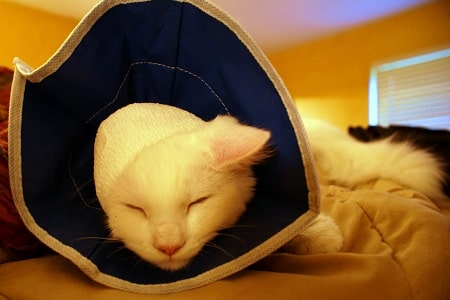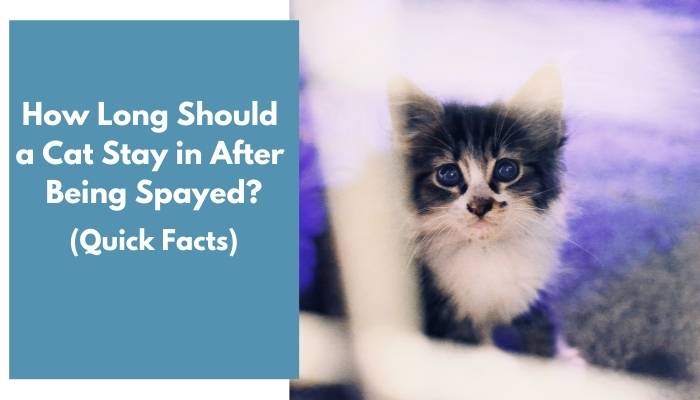Spaying is a surgery a female cat needs to avoid specific health issues. As a cat owner, you should know its importance, and you should plan on getting your cat spayed. If you do, then congratulations.
Since it’s a surgery, you may already know your cat shouldn’t go out for some time after spaying.
So, how long should a cat stay in after being spayed? You should keep your pet inside for at least two days after spaying. If you can make it longer, it would be better to do so. Keeping your cat in will help them recover and begin their natural healing process.
By letting your cat go out and roam around, you’re putting her at risk of infecting the wound of bacteria.
The best thing to do is to isolate your cat after getting it spayed.
Let’s get into it more!
Contents
- 1 How long to isolate a cat after a spay?
- 2 How soon can you release feral cats after spaying?
- 3 How long does it take for a cat to heal after being spayed?
- 4 Why should I keep a cat inside after being spayed?
- 5 What to do if a spayed cat wants to go outside?
- 6 Can you speed up the healing process?
- 7 Summary
- 8 Resources
How long to isolate a cat after a spay?
Isolating your cat after spaying is essential for its recovery, and it should be for at least two days. You can do so by keeping your cat in a secure room for at least two days.
By doing so, you prevent your cat’s wound from getting infected by bacteria. Moreover, you protect your pet from other people or animals while they recover.
Spaying a cat means it will have its body cut and stitched. Thus, your pet will be vulnerable to infections as the wound isn’t fully healed.
Once you put your pet in isolation, it would be best to keep it occupied by giving it something.
Moreover, it would also be best to a collar or anything to prevent it from licking and tearing the stitch.
As your pet recovers, make sure it gets plenty of sleep and nutrients. Thus, a nutritious diet and a quiet environment are ideal for them.
How soon can you release feral cats after spaying?
Both feral or stray cats and the domestic ones have similar recovery speed. Since both animals have a similar build, the recovery time may also be the same. Still, the feral cat may recover faster.
Feral or stray cats are familiar with living on their own. Thus, they can be entirely independent, and won’t be comfortable in your place.
Moreover, since they prefer more in the wild than indoors, it would probably take them less to recover.
Nevertheless, give the feral cat at least a day to recover. After a day, you can check its wounds and see if it’s healing fast.
A promising sign of recovery shows that the cat is fully conscious, clear-eyed, and alert. If you see any signs of weakness, it would be best to prolong the isolation before releasing.
As soon as you think the cat is good to go, you can already release it. Of course, always ask a vet’s opinion regarding the matter.
This way, you can ensure you’re preventing further complications after the spaying.
How long does it take for a cat to heal after being spayed?
Any incisions brought by surgeries like spaying generally take up to fourteen days. For this reason, it would be best to keep your feline pet under your observation for fourteen days.
Of course, it would be impossible with a cat’s attitude and personality to isolate them that long.
Nevertheless, they would need at least two days to recover from the surgery. After that time, you can let it roam around.
However, if you can, it would be best to keep your newly-spayed cat inside for at least two weeks.
This way, you can monitor and see the recovery of your pet. During that time, you also need to provide extra care and offer nutritious food for your pet.
Such things may be small, but it helps a lot for your pet to recover.
Why should I keep a cat inside after being spayed?
As I said earlier, a cat needs some time to heal the wounds from the surgery. For this reason, you need to keep your cat inside the house to give it time to recover.
You may keep your pet in isolation for one or two days. This way, the wounds from surgery would heal on its own.
After two days, your pet may start acting like its usual self again. While it’s alright for it to move around, it would be best to keep it inside for a few more days.
By keeping it inside, you don’t only let your pet recover. Moreover, it would prevent any infections possible.
Lastly, keeping your pet inside protects it from other people or animals.
Of course, you can always allow your pet outside. However, doing so would put your cat in danger of many things.
What to do if a spayed cat wants to go outside?
Cats have that curious and playful attitude which makes them inclined always to go outside. For this reason, don’t get surprised if your pet insists on going out all the time.
Though you can’t do anything to that attitude, you can always prevent your newly-spayed cat from going out. You can do the following things to keep your cat inside.
Offer snacks or treats.
The best way to keep a cat inside is by bribing it with treats or snacks it likes most.
A cat that sees and smells its favourite food or treat is always a sure way to win its attention.
If your pet tries to go out, give it a bite or two of the treat. Of course, it’s also important not to overdo it.
Keep your cat in a cat-proofed room.
A secure and safe room is ideal for keeping your cat from going out. Moreover, it’s one way to protect it from other animals, especially if you have other pets around.
Give some toys.
Cats are suckers for moving objects. Thus, you’ll surely grab your pet’s attention by giving it some moving toys it can play.
The trick regarding this matter is to drive your pet’s attention to remove its thought of going out.
As long as you understand your pet, preventing it from going out will be an easy task.
Can you speed up the healing process?
There’s no precise way to speed up a cat’s healing process. However, there are some things you can do to help your pet as it recovers from the spaying surgery.
Consider the following steps in taking care of your pet. You may find a thing or two useful in caring for your pet after getting it spayed.
Keep your cat calm.
Keeping your cat calm means not allowing it to do some great activities. Among these are running, jumping, and excessive playing.
Cats easily get stimulated by moving things. Thus, the best way to deal with such is not to give your pet any reason to do such acts.
It can be challenging for younger felines, since they may feel better after a short time only. However, try your best to grab your pet’s attention and avoid such activities.
By avoiding such movements, you lessen the possibility of the wounds to open. Thus, it would lead to a fast and quick recovery.
Keep your cat inside.
As I said earlier, keeping your cat inside does many things for your pet. For instance, keeping your cat inside prevents infections from bacteria outside.
It will also ensure that your feline pet wouldn’t be jumping from heights and running too much.
Moreover, you’ll give your cat’s body some time to heal on its own. Lastly, you protect your pet from getting harassed by other pets, and even other people.
Observe the incisions from the surgery.
Always take note of the changes in the wounds brought by the spaying. Make sure it’s not bleeding, red, or even swollen.
Cats tend to lick those wounds, which can lead to disinfection. If it appears as such, consider taking it to the vet again.
You can see if your cat is recovering and if it’s alright to allow it outside by careful observation. It will also prevent complications from getting worse.
Put a recovery collar on your pet.
A recovery collar is useful to prevent your pet from accessing the incision. Felines tend to lick the wounds and cut the stitches.
A recovery collar would prevent such things from happening. Your vet will give you a certain period for its use. Please don’t take it off your pet until the designated date come.

Follow all instructions from the vet.
After the surgery, your vet will give you specific instructions on what to do for your pet. Some of the usual things would be:
- Keeping the surgery wound clean
- Keeping the wound coated with ointments
- Providing your pet with antibiotics
- Carefully observing how the wound recovers
Whatever the recommendations and instructions are, be sure to do it all for your pet’s health. This way, your cat’s recovery process would improve.
Give your pet extra care and attention.
After getting spayed, your cat would be weaker. Thus, it means that your pet needs more help than it usually gets.
For this reason, it wouldn’t hurt if you give it a little bit more care and attention than usual.
Cats need extra energy and nutrients. Thus, you may need to provide quality and nutritious food for your pet.
Moreover, it also needs some quiet and safe environment to get a good rest. Thus, providing a cat-proofed room is a sure way to get it done.
Summary
If your cat just got spayed recently, it would be best to keep it inside for at least two days or more. By keeping it inside, you’ll allow some time for your pet to recover. Moreover, it will prevent any further complications and would protect your pet from other pets.
Spaying is essential for any female cats and their owners. It keeps them safe from health complications concerning their ovaries and other related parts.
While the surgery itself is crucial, it’s also essential to pay attention to caring for your pet afterwards.
The spaying won’t be a sure success if your pet gets other complications afterwards.
For this reason, always make sure your pet stays inside after spaying, and that it receives proper care and attention.
Resources
Image credits – Canva, Wikimedia
[1] Current perspectives on the optimal age to spay/castrate dogs and cats – NCBI
[2] Evaluating the benefits and risks of neutering dogs and cats – ResearchGate
[3] Early Spay/Neuter in the Cat – CFA.org
[4] The Optimal Age for Spay/Neuter – Mississippi State University



